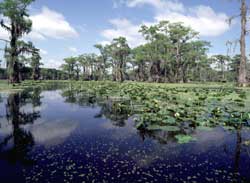Biology professors conduct groundbreaking research
 |
Fort Worth, TX
7/7/2008
A first-of-its-kind study at Caddo Lake shows mercury levels that rival saltwater bodies in other countries, an aquatic researcher said Tuesday.
Early findings of a study of mercury in fish, plants and animals in the Caddo Lake watershed were presented before more than 60 lake stakeholders at the Jeffersonian Institute. State environmental regulators issued a fish advisory for Caddo Lake and its chief tributary, Big Cypress Creek, about a decade ago, asking residents to limit their fish consumption from the water bodies, according to Matt Chumchal, a Texas Christian University professor.
It's the first time researchers have studied mercury levels in a freshwater system's food chain — a technique previously limited to saltwater bodies, Chumchal said.
Species samples revealed high levels of mercury in snakes, raccoons and fish — animals near the top of the Caddo Lake food chain. The study also shows significant liver function damage among tested raccoons and snakes, he said.
Average mercury concentrations in snakes at Caddo Lake were more than twice the rate of concentrations at many other East Texas lakes and higher than the maximum mercury concentration in snakes from several other states, Canada, Yugoslavia and other nations, he said.
Most surprising were the locations along Caddo Lake with the highest mercury samples, Chumchal said. Mercury levels were higher in organisms found in the lake's western wetland-dominated areas, and the highest levels were found at Texas 43's bridge over Big Cypress Creek where it feeds into the lake.
"Prior to this study, it was widely thought that it would be homogenous (or consistent) across a lake," the professor said. "We're not sure exactly what's going on here."
Sources for the mercury have not been determined, he said. Caddo Lake's 6,000-square-mile watershed involves much of Northeast Texas — from northern Gregg County to Cass, Morris and Titus counties — and includes areas with high mercury deposition rates, he said.
The study also shows that biomagnification — the increase of a substance's concentration in a food chain — is occurring at Caddo Lake. Snakes, raccoons and largemouth bass are near the top of the lake's food chain and have the highest mercury levels of all tested species, including plants, grass shrimp and other prey, Chumchal said.
"Since the industrial revolution (beginning in the late 18th century), we've had a large increase in mercury in the environment," he said. "Unfortunately in this area, we just don't have the sampling to suggest how data has changed over the last several decades."
Organisms have mechanisms to excrete metals such as mercury, but problems can develop when those organisms are exposed to higher concentrations of the metal.
"That information tells us that there's still a lot of unknown information, and we need to get more data collection," said Walt Sears, general manager for Northeast Texas Municipal Water District, who presided over Tuesday's stakeholders' meeting. Sears said stakeholders must be more energetic about controlling nutrients that affect mercury levels in Caddo Lake.
"Up until today's report, the commonly held thought was the mercury was the same level throughout Caddo Lake," he said. "This information clearly illustrates that the exposure varies, and it is higher in the wetlands area and higher still in the river portion."
The Caddo Lake Institute and support from Texas Christian University and Texas Tech University are funding the study, Sears said.
(used with the permission of the Longview News-Journal)










